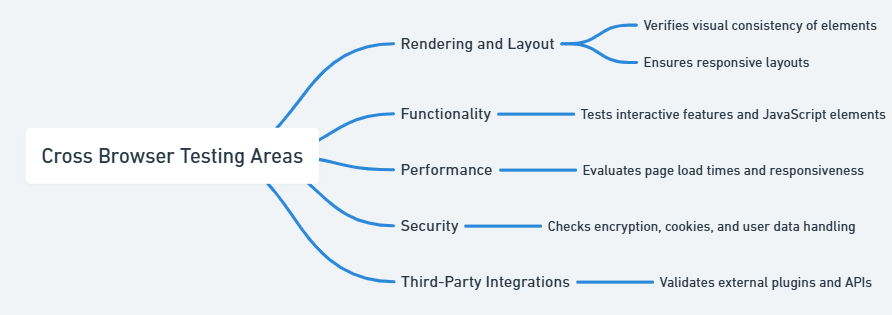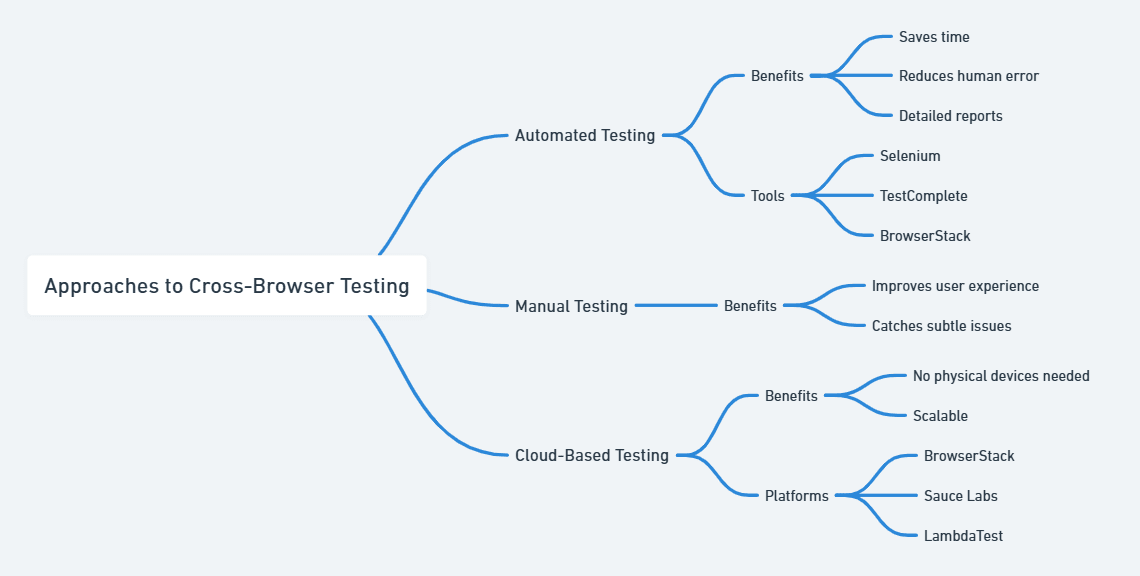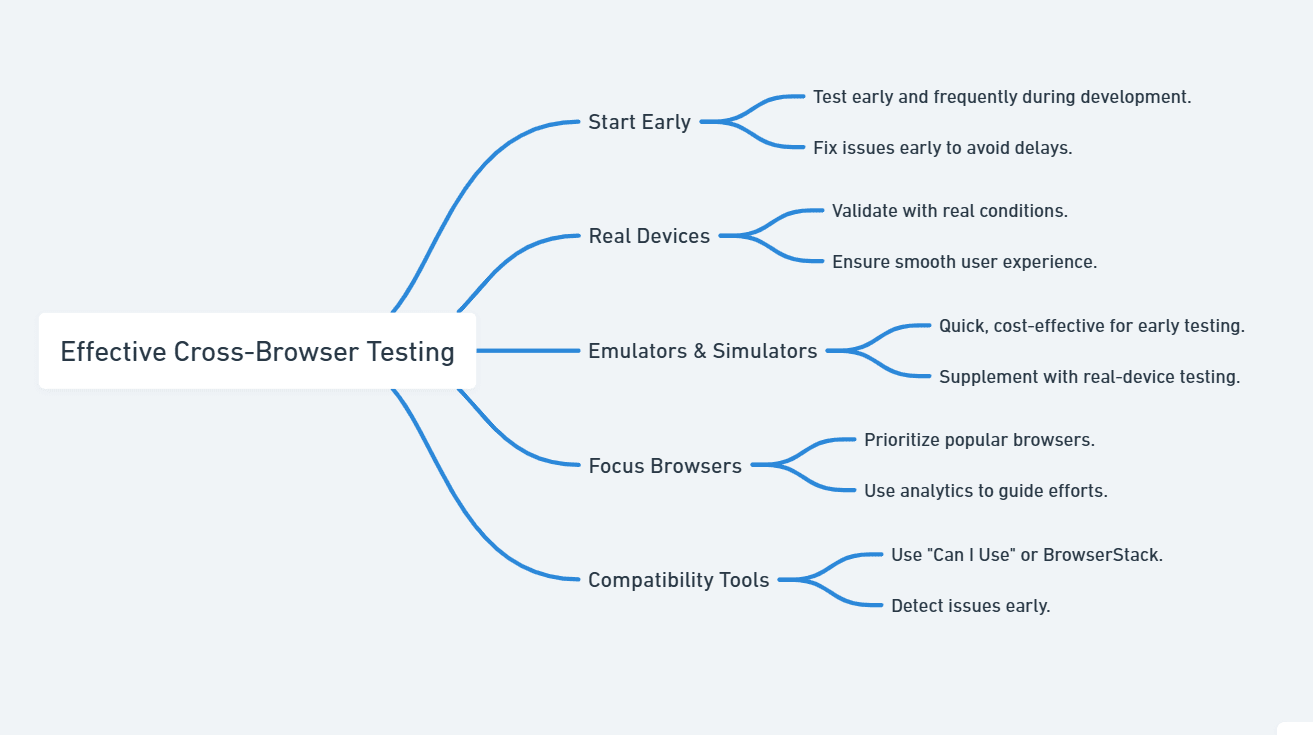Cross Browser Testing for Web & Mobile Applications
Web-based applications continue to be part of the modern connected experience, whether for banking, entertainment, health, or others.

As a result, cross-browser testing remains critical to ensuring optimal user experience across different platforms (Windows, Mac, Linux, etc.) and browsers.
While the “Browser Wars” are over, testing across browser engines—not just browsers—remains crucial. This ensures accurate rendering, proper JavaScript execution, and seamless performance of frameworks like WebAssembly in modern web applications.
Cross browser testing is no longer optional in today’s digital landscape, where users demand flawless experiences on an ever-expanding range of devices and browsers.
Without this critical step, even the most visually stunning or feature-rich websites risk alienating users due to poor functionality or design inconsistencies.
By making cross browser testing a fundamental part of your product and development workflow, you can build trust, expand your reach, and meet the expectations of a diverse audience.
In this article, we’ll explore the essentials of cross-browser testing, including its use cases, and effective approaches for implementation. We’ll also cover key practices to ensure your testing efforts yield optimal results.
Table of Contents
- What is Cross Browser Testing?
- Why is Cross Browser Testing Important?
- What Areas Are Commonly Tested?
- Use Cases for Cross Browser Testing
- The Top Rendering Engines or “Browser Technologies” to Test
- The Top Browsers to Test
- Other Web Technologies to Add to Your Testing Scope
- Approaches to Cross Browser Testing
- How to Conduct Effective Cross Browser Testing
- Best Practices for Cross Browser Testing
- How Testlio Supports Cross-Browser Testing
What is Cross Browser Testing?
Cross browser testing is a quality assurance (QA) process that ensures a website or web application performs seamlessly across a variety of browsers, devices, and operating systems.
With each browser interpreting code differently, there is always a risk that features, layouts, or functionalities may not behave as expected for every user.
Cross browser testing helps developers identify and resolve these issues, delivering a consistent and enjoyable user experience.
The ultimate goal here is to uncover inconsistencies in how different browsers render elements such as HTML, CSS, and JavaScript.
For example, a feature that works perfectly on Google Chrome might behave differently on Safari or Edge due to variations in their rendering engines.
Ultimately, the goal is to ensure that all users, regardless of their browser or device, can access and interact with the website without encountering errors or usability challenges.
This approach improves accessibility, boosts user satisfaction, and minimizes the risk of alienating any audience segment.
Why is Cross Browser Testing Important?
Cross-browser testing is crucial in modern web development as it ensures a consistent user experience, accessibility, and brand perception across platforms.
Users access websites through various devices, operating systems, and browsers, so inconsistencies can lead to a poor experience and potential audience loss.
Key reasons for its importance include:
- Diverse browsers and devices:
Users access websites through multiple browsers, such as Google Chrome, Safari, Firefox, and Edge, on platforms ranging from smartphones to smart TVs. Each browser processes code differently, potentially leading to inconsistencies.Cross browser testing ensures your website functions correctly across all these combinations, preventing surprises for end users.
- Protecting brand reputation:
A glitchy website can frustrate users and harm your brand’s credibility. Visitors are less likely to return if a website fails to load, has design errors, or features that don’t work on certain browsers.It safeguards your brand by providing a polished and reliable experience to every user.
- Enhancing accessibility:
Cross browser testing also plays a vital role in inclusivity. People from all walks of life, including those with disabilities, use different browsers and assistive technologies.Testing ensures accessibility features, such as keyboard navigation, screen readers, or color contrasts, work properly on all browsers.
What Areas Are Commonly Tested?
Cross browser testing covers multiple aspects of a website to ensure that it functions as intended on different browsers and devices. Each area contributes to a seamless, consistent user experience and prevents compatibility issues.
Key Areas of Cross-Browser Testing
Let’s look into the areas commonly tested:
- Rendering and layout: Verifies visual elements such as fonts, images, colors, and spacing appear consistently. It also ensures responsive layouts work smoothly across various screen sizes.
Example: A navigation bar may appear aligned on Chrome but could overlap with content on Safari.
- Functionality: Ensures that interactive features like buttons, forms, and menus work properly. JavaScript-driven elements are also tested to avoid browser-specific issues.
Example: A form submission button might work perfectly in Firefox but fails to respond in Edge due to different browsers’ interpretation of JavaScript events.
- Performance: Focuses on page load times and responsiveness. If not tested, variations in how browsers handle caching and rendering can lead to slow performance.
Example: It is crucial for retaining users to ensure that your website doesn’t take significantly longer to load on Internet Explorer than on Chrome.
- Security: Identifies vulnerabilities in how browsers handle encryption, cookies, and user data, ensuring consistent user protection.
Example: Testing ensures that user login data remains encrypted and safe regardless of the browser used.
- Third-party integrations: Verifies the functionality of external plugins and APIs, which may behave inconsistently across browsers.
Example: A payment gateway might work flawlessly in Chrome but fail to display in Safari due to browser-specific API limitations.
Use Cases for Cross Browser Testing
Cross browser testing serves crucial roles in multiple scenarios, helping developers ensure consistent functionality and user experience across different platforms:
- E-commerce websites
E-commerce platforms need to provide a flawless experience for users at every step, from product browsing to checkout. Any issue, such as broken payment buttons or misaligned product images, can lead to cart abandonment and lost revenue. - SaaS applications
Software-as-a-Service (SaaS) products are often accessed on a wide variety of devices and browsers. Testing ensures that features, dashboards, and integrations work smoothly, regardless of the environment users operate in. - Content-heavy websites
Websites rich in multimedia elements like images, videos, and animations require thorough testing. This ensures that these elements render correctly on all browsers without performance drops or visual inconsistencies. - Accessibility compliance
Testing ensures that accessibility features like screen reader compatibility and keyboard navigation work seamlessly across browsers. This is critical for meeting accessibility standards and serving users with disabilities effectively. - Responsive design
With users accessing websites on devices of varying screen sizes, testing ensures layouts, navigation, and features adjust perfectly for desktops, tablets, and smartphones, providing a consistent experience.
The Top Rendering Engines or “Browser Technologies” to Test
Cross-browser testing must include rendering engines, the core technologies that determine how content is processed and displayed. These engines power browsers and interpret HTML, CSS, JavaScript, and multimedia, often leading to subtle differences in functionality and performance.
- Chromium (Base for Chrome, Edge, Opera, and more)
As an open-source engine for most popular browsers today, Chromium supports advanced web standards, cutting-edge features, and frequent updates. Testing on Chromium ensures compatibility with the foundational technology of many popular browsers. - WebKit (Used by Safari)
The engine behind macOS and iOS browsing, WebKit is known for its unique interpretations of CSS and HTML. Testing is essential to validate responsive designs, touch gestures, and font rendering on Apple devices. - Blink (Used by Chrome, Edge, Opera)
A fork of WebKit, Blink powers Chromium-based browsers and is optimized for speed and innovation. Cross-browser testing ensures features like CSS animations, JavaScript-heavy applications, and WebAssembly modules work flawlessly. - Gecko (Used by Firefox)
Recognized for its privacy-first approach and developer-centric tools, Gecko often handles web standards differently. Testing ensures alignment with its tracking prevention, cookie handling, and advanced security features. - Trident and EdgeHTML (Legacy Microsoft Technologies)
While mostly replaced by Chromium-based Edge, these engines still exist in legacy enterprise environments. Testing for backward compatibility ensures accessibility for older platforms.
The Top Browsers to Test
When testing, it’s essential to focus on browsers that hold significant market share or cater to specific user demographics. Each browser processes code differently, meaning a website might behave uniquely on each.
Here’s how cross browser testing relates to the key browsers:
- Google Chrome
As the most popular browser worldwide, Chrome sets the standard for modern web performance. Testing on Chrome ensures compatibility with a browser that boasts advanced rendering engines and frequent updates.Testing on Chrome helps validate CSS animations, JavaScript-heavy applications, and integrations with Google services.
- Mozilla Firefox
Firefox is favored for its robust security and developer-friendly tools. It often handles certain web standards differently, particularly around privacy-focused features like cookie handling and tracking prevention.Testing ensures your site or app remains functional while respecting these security protocols.
- Apple Safari
Safari dominates the macOS and iOS markets, making it vital for testing responsive designs and touch-friendly features. Safari’s WebKit rendering engine interprets HTML and CSS in a unique way.Testing is essential to ensure that layouts, fonts, and interactive elements like forms function consistently on Apple devices.
- Microsoft Edge
Built on the Chromium engine, Edge provides a modern browsing experience, especially for Windows users. However, its unique Windows integrations and security settings require testing to verify compatibility, especially for enterprise-level applications. - Opera
While it serves a niche audience, Opera is known for speed and features like built-in ad blockers and VPNs. Cross browser testing ensures these unique features don’t interfere with website performance, especially for multimedia-heavy sites.
Other Web Technologies to Add to Your Testing Scope
Modern web applications rely on a wide range of technologies that enhance interactivity, graphics, and user experience. Testing these ensures your application works consistently across browsers and platforms.
- JavaScript Frameworks and Libraries
Frameworks like React, Angular, and Vue are essential for building dynamic, client-side features. Testing ensures smooth operation regardless of the browser engine. - WebAssembly
Ideal for high-performance web applications, WebAssembly enables complex computing tasks directly in the browser. Testing ensures compatibility across all major engines. - Progressive Web App (PWA) Features
PWAs rely on features like service workers, offline functionality, and push notifications. Cross-browser testing ensures these work uniformly across browsers. - WebGL (Web Graphics Library)
WebGL is critical for rendering interactive 2D and 3D graphics in the browser. Testing across engines ensures consistent performance for applications requiring advanced visualizations, simulations, or gaming. - Media and Graphics APIs
Real-time communication tools like WebRTC and multimedia playback rely on robust API support. Testing ensures seamless user experiences for video conferencing, streaming, and media-heavy applications.
Approaches to Cross Browser Testing
Employing effective strategies for cross-browser testing is crucial to ensuring a seamless user experience across diverse platforms.
Methods for Effective Cross-Browser Testing
Automated testing
Automated testing leverages specialized tools and pre-written scripts to assess a website’s functionality and compatibility across multiple browsers.
This method excels at handling repetitive tasks, like regression testing, which involves rechecking existing functionality after updates or changes.
By automating these tests, teams save significant time and effort.
Benefits:
- Saves time by running tests in parallel: Automated tools can execute multiple tests simultaneously, speeding up the testing process.
- Reduces human error: Since the process is automated, there’s less risk of oversight or inconsistencies that might occur with manual testing.
- Provides detailed reports for debugging: Automated tools generate logs and reports that help developers quickly pinpoint and resolve issues.
Popular Tools:
- Selenium: A versatile tool for browser automation.
- TestComplete: Offers a user-friendly interface for creating automated tests.
- BrowserStack: A cloud-based platform for automated and manual testing across numerous browser and device combinations.
Manual testing
Manual testing requires human testers to interact directly with the website across different browsers to identify compatibility issues. Though time-intensive, it provides valuable insights into usability and aesthetic design, areas where automation may fall short.
Benefits:
- Offers insights into user experience: Human testers can evaluate how intuitive the website feels and how well it meets user expectations.
- Detects subtle design or functionality issues: Manual testing can catch certain visual elements or interactive features that might look fine in automated tests.
Cloud-based testing
Cloud-based testing platforms offer virtual environments that simulate various browsers, operating systems, and devices. This eliminates the need to maintain an in-house library of physical devices while enabling teams to scale their testing efforts based on their project needs.
Benefits:
- Eliminates the need for physical devices: Testers can access various browser and device configurations without investing in hardware.
- Scalable for teams with diverse testing needs: Cloud platforms can accommodate multiple users and environments, making them ideal for collaborative teams.
Popular Platforms:
- BrowserStack: Provides on-demand access to real browsers and devices.
- Sauce Labs: A robust solution for cloud-based testing across platforms.
- LambdaTest: Simplifies the testing process with various browser and OS combinations.
How to Conduct Effective Cross Browser Testing
With a clear understanding of the importance of starting early in the development process, it becomes evident how crucial early testing is.
Let’s now discuss other essential strategies for conducting effective cross-browser testing to ensure seamless user experiences.
Key Strategies for Effective Cross-Browser Testing
1. Start early
Incorporate cross-browser testing at the earliest stages of development to avoid major issues later in the process. This means running tests as new features are added or as designs are implemented.
Addressing compatibility issues early minimizes the risk of delays and reduces the time spent troubleshooting bugs closer to launch, which can be more resource-intensive.
2. Test on real devices
Although emulators provide a baseline understanding of how a website might behave, testing on real devices gives the most accurate results. Real devices allow developers to see the site’s performance under authentic conditions, such as varied screen resolutions, touch interactions, and hardware differences.
This ensures a smoother user experience across actual user scenarios.
3. Use emulators and simulators
For teams with limited resources, emulators and simulators offer a cost-efficient alternative to test compatibility across different browsers and devices. These tools mimic real devices and are useful for quickly identifying obvious issues during early testing.
However, they do not replace real-device testing as they might miss nuances like hardware-specific bugs or performance bottlenecks.
4. Prioritize browsers
Testing every possible browser and version is often unnecessary and inefficient. Instead, focus on the browsers most commonly used by your audience.
Tools like Google Analytics provide data on user preferences, such as browser type and version, helping you prioritize testing efforts where they will have the greatest impact.
5. Use browser compatibility checkers
Browser compatibility tools, such as Can I Use or BrowserStack’s compatibility checker, help developers verify whether specific features, like CSS properties or JavaScript APIs, are supported across target browsers.
These tools save time by identifying potential issues before testing begins and ensuring the maintenance of clean, functional code.
Best Practices for Cross Browser Testing
By implementing these strategies, you can ensure that your cross-browser testing process is thorough and effective, paving the way for seamless user experiences across all platforms.
- Create a comprehensive test plan: A detailed test plan is essential to cover all critical aspects of cross-browser compatibility.
This includes defining the scope of the testing, identifying the browsers, devices, and operating systems to test, and specifying the features and functionality to focus on.
A well-structured plan helps teams stay organized and ensures nothing important is overlooked.
- Leverage automation: Automation tools like Selenium or BrowserStack streamline repetitive tasks, such as running the same test across multiple browsers. This saves time, improves efficiency, and ensures consistency in testing.
Automated testing is particularly beneficial for regression testing, where the same functionality needs to be repeatedly verified after updates.
- Test incrementally: Conducting tests regularly throughout the development lifecycle helps catch issues early before they become deeply embedded in the codebase.
This approach reduces the time and cost of fixing bugs and ensures that browser compatibility is maintained as new features are introduced.
- Keep testing environments updated: Browsers and devices evolve constantly, with frequent updates and new releases.
Ensuring that your testing environments reflect these changes helps catch compatibility issues that might arise with newer versions. This approach keeps your website aligned with evolving user preferences.
- Document and solve bugs: Maintaining a detailed log of identified issues and their resolutions ensures a smoother testing process in the future.
Proper documentation helps developers identify recurring problems and track progress effectively. It also facilitates sharing insights with the team, ultimately improving the overall quality and efficiency of future testing cycles.
How Testlio Supports Cross-Browser Testing
Cross-browser testing is essential for delivering a consistent, high-quality user experience. Testlio can help you ensure your website performs flawlessly across platforms while safeguarding your brand’s reputation.
Here’s how Testlio can help:
- Integrated testing workflow: Leverage Testlio’s expertise to make cross-browser testing a standard part of your development process.
- Seamless user experience: Ensure a consistent look and functionality for all users, regardless of browser or device.
- Broader audience reach: Address compatibility issues to make your website accessible to a diverse user base.
- Brand reliability: Build trust and professionalism by eliminating compatibility-related frustrations.

Contact us to see how our services can help your team achieve seamless cross-browser compatibility, resolve compatibility issues, and ensure a flawless user experience across all platforms.



